Urban–Rural PM2.5 Dynamics in Kraków, Poland: Patterns and Source Attribution
Abstract
1. Introduction
- (1)
- A measurable difference exists between air pollution patterns in urban Kraków and in the neighboring municipalities, and this contrast disappears after the heating season.
- (2)
- Particle transport path analysis can more precisely connect low-emission sources with the locations where their impact is observed.
- (3)
- Practical use of HYSPLIT for large-batch analyses, even with a limited number of monitoring sites, requires parallel computations.
2. Materials and Methods
2.1. Study Area
2.2. Data Collection
2.3. Statistical Analysis
2.4. Trajectory Modeling
2.5. Instrumentation
3. Results
4. Discussion
5. Conclusions
Author Contributions
Funding
Data Availability Statement
Conflicts of Interest
References
- State of Global Air 2024; EEA Report: Copenhagen, Denmark, 2024.
- European Environment Agency (EEA). Air Quality in Europe 2022—Health Impacts of Air Pollution: Table 2; EEA: Copenhagen, Denmark, 2022; Available online: https://www.eea.europa.eu/publications/air-quality-in-europe-2022/health-impacts-of-air-pollution-table2 (accessed on 10 September 2025).
- ESCAPE (European Study of Cohorts for Air Pollution Effects, 2019). Available online: https://cordis.europa.eu/project/id/211250 (accessed on 10 September 2025).
- Raaschou-Nielsen, O.; Andersen, Z.J.; Beelen, R.; Samoli, E.; Stafoggia, M.; Weinmayr, G.; Hoffmann, B.; Fischer, P.; Nieuwenhuijsen, M.J.; Brunekreef, B.; et al. Air pollution and lung cancer incidence in 17 European cohorts: Prospective analyses from the European Study of Cohorts for Air Pollution Effects (ESCAPE). Lancet Oncol. 2013, 14, 813–822. [Google Scholar] [CrossRef] [PubMed]
- Weinmayr, G.; Romeo, E.; De Sario, M.; Weiland, S.; Forastiere, F. Short-term effects of PM10 and NO2 on respiratory health in children with asthma or asthma-like symptoms: A systematic review and meta-analysis. Environ. Health Perspect. 2010, 118, 449–457. [Google Scholar] [CrossRef] [PubMed]
- Dąbrowiecki, P.; Chciałowski, A.; Dąbrowiecka, A.; Piórkowska, A.; Badyda, A. Air pollution and long-term risk of hospital admission due to chronic obstructive pulmonary disease exacerbations in Poland: A time-stratified, case-crossover study. Polskie Arch. Med. Wewnętrznej 2023, 133, 1–7. [Google Scholar] [CrossRef]
- Szikowski, T.; Adam, M.; Marcon, A.; Cai, Y.; Vierkötter, A.; Carsin, A.E.; Jacquemin, B.; Al Kanani, Z.; Beelen, R.; Birk, M.; et al. Ambient air pollution and the incidence and prevalence of COPD. Eur. Respir. J. 2014, 44, 614–626. [Google Scholar] [CrossRef] [PubMed]
- MacIntyre, E.A.; Gehring, U.; Molter, A.; Fuertes, E.; Klümper, C.; Kramer, U.; Quass, U.; Hoffmann, B.; Gascon, M.; Brunekreef, B.; et al. Air pollution and respiratory infections in early childhood: An analysis of 10 European birth cohorts within the ESCAPE project. Environ. Health Perspect. 2014, 122, 107–113. [Google Scholar] [CrossRef] [PubMed]
- Cesaroni, G.; Forastiere, F.; Stafoggia, M.; Andersen, Z.J.; Badaloni, C.; Beelen, R.; Caracciolo, B.; de Faire, U.; Erbel, R.; Eriksen, K.T.; et al. Long term exposure to ambient air pollution and incidence of acute coronary events: Prospective cohort study and meta-analysis in 11 European cohorts from the ESCAPE Project. BMJ 2014, 348, f7412. [Google Scholar] [CrossRef] [PubMed]
- Burte, E.; Leynaert, B.; Bono, R.; Brunekreef, B.; Bousquet, J.; Carsin, A.E.; De Hoogh, K.; Forsberg, B.; Gormand, F.; Heinrich, J.; et al. Association between air pollution and rhinitis in two European cohorts. Environ. Int. 2018, 115, 257–266. [Google Scholar] [CrossRef] [PubMed]
- Kwon, D.; Paul, K.C.; O’Sharkey, K.; Paik, S.A.; Yu, Y.; Bronstein, J.M.; Ritz, B. Challenges in studying the impact of air pollution on neurodegenerative diseases. Environ. Res. 2025, 278, 121597. [Google Scholar] [CrossRef] [PubMed]
- Główny Inspektorat Ochrony Środowiska (GIOŚ). Poziomy Dopuszczalne Zanieczyszczeń w Powietrzu ze Względu na Ochronę Zdrowia Ludzi i Ochronę Roślin, Terminy ich Osiągnięcia Oraz Okresy, Dla Których Uśrednia się Wyniki Pomiarów; GIOŚ: Warsaw, Poland, 2015. Available online: https://powietrze.gios.gov.pl/pjp/content/annual_assessment_air_acceptable_level# (accessed on 10 September 2025).
- World Health Organization (WHO). WHO Global Air Quality Guidelines. Particulate Matter (PM2.5 and PM10), Ozone, Nitrogen Dioxide, Sulfur Dioxide and Carbon Monoxide; WHO: Geneva, Switzerland, 2021; Available online: https://iris.who.int/bitstream/handle/10665/345329/9789240034228-eng.pdf?sequence=1&isAllowed=y (accessed on 10 September 2025).
- Directive (EU) 2024/2881 of the European Parliament and of the Council of 23 October 2024 on Ambient Air Quality and Cleaner Air for Europe EU: 2024. Available online: https://eur-lex.europa.eu/legal-content/PL/TXT/PDF/?uri=OJ:L_202402881 (accessed on 10 September 2025).
- Bokwa, A. Development of research on the local climate of Kraków. Acta Geogr. Lodz. 2019, 108, 7–20. [Google Scholar]
- Sejmik Województwa Małopolskiego. Resolution No. XVIII/243/16 of the Małopolska Regional Assembly of 15 January 2016 on Introducing Restrictions on the Operation of Installations Using Fuel Combustion in the City of Kraków; Official Journal of the Małopolska Region: Kraków, Poland, 2016. [Google Scholar]
- Polski alarm smogowy. Kraków Nie Jest Już Stolicą Smogu—Historyczna Poprawa Jakości Powietrza; Polski alarm smogowy: Warsaw, Poland, 2024; Available online: https://polskialarmsmogowy.pl/2024/05/krakow-nie-jest-juz-stolica-smogu-historyczna-poprawa-jakosci-powietrza/ (accessed on 10 September 2025).
- Danek, T.; Zaręba, M. Using public data from low-cost sensors for geospatial analysis of air pollution from solid fuel heating during the spring COVID-19 pandemic in Kraków. Sensors 2021, 21, 5208. [Google Scholar] [CrossRef] [PubMed]
- Sejmik Województwa Małopolskiego. Resolution No. LIX/842/22 of the Małopolska Regional Assembly of 26 September 2022 Amending Resolution No. XXXII/452/17 of 23 January 2017 on Introducing Restrictions and Prohibitions in the Operation of Installations Using Fuel Combustion in the Małopolska Region; Official Journal of the Małopolska Region: Kraków, Poland, 2022. [Google Scholar]
- EN 303-5:2012; Heating Boilers—Part 5: Heating Boilers for Solid Fuels, Hand and Automatically Stoked, Nominal Heat Output of up to 500 kW—Terminology, Requirements, Testing and Marking. CEN: Brussels, Belgium, 2012; Polish version: PN-EN 303-5:2012, Polish Committee for Standardization (PKN): Warsaw, Poland.
- Portal Samorządowy. Kraków Przeprowadził Pomiary Ruchu Drogowego. Wiadomo Już, Gdzie Jest Najgorzej; Portal samorządowy: Katowice, Poland, 2024; Available online: https://www.portalsamorzadowy.pl/wydarzenia-lokalne/krakow-przeprowadzil-pomiary-ruchu-drogowego-wiadomo-juz-gdzie-jest-najgorzej,574610.html?mp=promo (accessed on 10 September 2025).
- Kraków City Council. Resolution No. XXXII/619/25 of the Kraków City Council of 12 June 2025 on Establishing the Clean Transport Zone in Kraków; Official Journal of the Małopolska Voivodeship: Kraków, Poland, 2025; Item 3829. [Google Scholar]
- Stein, A.F.; Draxler, R.R.; Rolph, G.D.; Stunder, B.J.B.; Cohen, M.D.; Ngan, F. NOAA’s HYSPLIT atmospheric transport and dispersion modeling system. Bull. Am. Meteorol. Soc. 2015, 96, 2059–2077. [Google Scholar] [CrossRef]
- Draxler, R.R. HYSPLIT4 User’s Guide. In NOAA Tech. Memo. ERL ARL-230; NOAA Air Resources Laboratory: Silver Spring, MD, USA, 1999. [Google Scholar]
- Draxler, R.R.; Hess, G.D. An overview of the HYSPLIT_4 modeling system of trajectories, dispersion, and deposition. Aust. Meteorol. Mag. 1998, 47, 295–308. [Google Scholar]
- Draxler, R.R.; Hess, G.D. Description of the HYSPLIT_4 modeling system. In NOAA Tech. Memo. ERL ARL-224; NOAA Air Resources Laboratory: Silver Spring, MD, USA, 1997; p. 24. [Google Scholar]
- Breiman, L. Random Forests. Mach. Learn. 2001, 45, 5–32. [Google Scholar] [CrossRef]
- Wright, M.N.; Ziegler, A. ranger: A Fast Implementation of Random Forests for High Dimensional Data in C++ and R. J. Stat. Softw. 2017, 77, 1–17. [Google Scholar] [CrossRef]
- Iannone, R. splitr: Use the HYSPLIT Model from Inside R. R Package Version 0.4.0.9000. Available online: https://github.com/rich-iannone/splitr (accessed on 10 September 2025).
- KOBiZE. Wskaźniki Emisji Zanieczyszczeń ze Spalania Paliw Dla Źródeł o Nominalnej Mocy Cieplnej do 5 MW, Zastosowane do Automatycznego Wyliczenia Emisji w Raportach do Krajowej Bazy za Lata 2022–2024 [Emission Factors of Pollutants from Fuel Combustion in Sources with a Nominal Thermal Input up to 5 MW, Applied for the Automatic Calculation of Emissions in National Database Reports for 2022–2024]; Institute of Environmental Protection—National Research Institute (IOŚ-PIB): Warsaw, Poland, 2025; Available online: https://kobize.pl (accessed on 10 September 2025).
- Baddeley, A.; Rubak, E.; Turner, R. Spatial Point Patterns: Methodology and Applications with R; Chapman & Hall/CRC Press: London, UK, 2015; ISBN 978-1-4822-1020-0. [Google Scholar]
- Bengtsson, H. A Unifying Framework for Parallel and Distributed Processing in R Using Futures. R J. 2021, 13, 208–227. [Google Scholar] [CrossRef]
- Vaughan, D.; Dancho, M. furrr: Apply Mapping Functions in Parallel Using Futures, R Package Version 0.3.1; Comprehensive R Archive Network (CRAN): Vienna, Austria, 2022. [Google Scholar]
- Jandacka, D.; Durcanska, D.; Nicolanska, M.; Holubcik, M. Impact of Seasonal Heating on PM10 and PM2.5 Concentrations in Sučany, Slovakia: A Temporal and Spatial Analysis. Fire 2024, 7, 150. [Google Scholar] [CrossRef]
- Samek, L.; Stegowski, Z.; Furman, L.; Styszko, K.; Zajusz-Zubek, E.; Michalik, J. Seasonal variation in chemical composition of PM2.5 in Kraków, Poland. Water Air Soil Pollut. 2017, 228, 3483. [Google Scholar] [CrossRef]
- WIOŚ Kraków. Jakość Powietrza w Krakowie: Podsumowanie Wyników Badań. 2020. Available online: https://krakow.wios.gov.pl/2020/09/jakosc-powietrza-w-krakowie-podsumowanie-wynikow-badan/ (accessed on 3 October 2025).
- Bogacki, M.; Widziewicz, K.; Puta, R. Low-stack emission as the dominant factor of air pollution in Kraków. E3S Web Conf. 2018, 44, 00053. [Google Scholar] [CrossRef]
- Rogula-Kozłowska, W.; Majewski, G.; Rogula-Kopiec, P.; Pastuszka, J.S.; Mathews, B.; Sówka, I. Contribution of residential heating and traffic to PM2.5 during and after COVID-19 restrictions in Kraków, Poland. Appl. Sci. 2023, 13, 11492. [Google Scholar] [CrossRef]

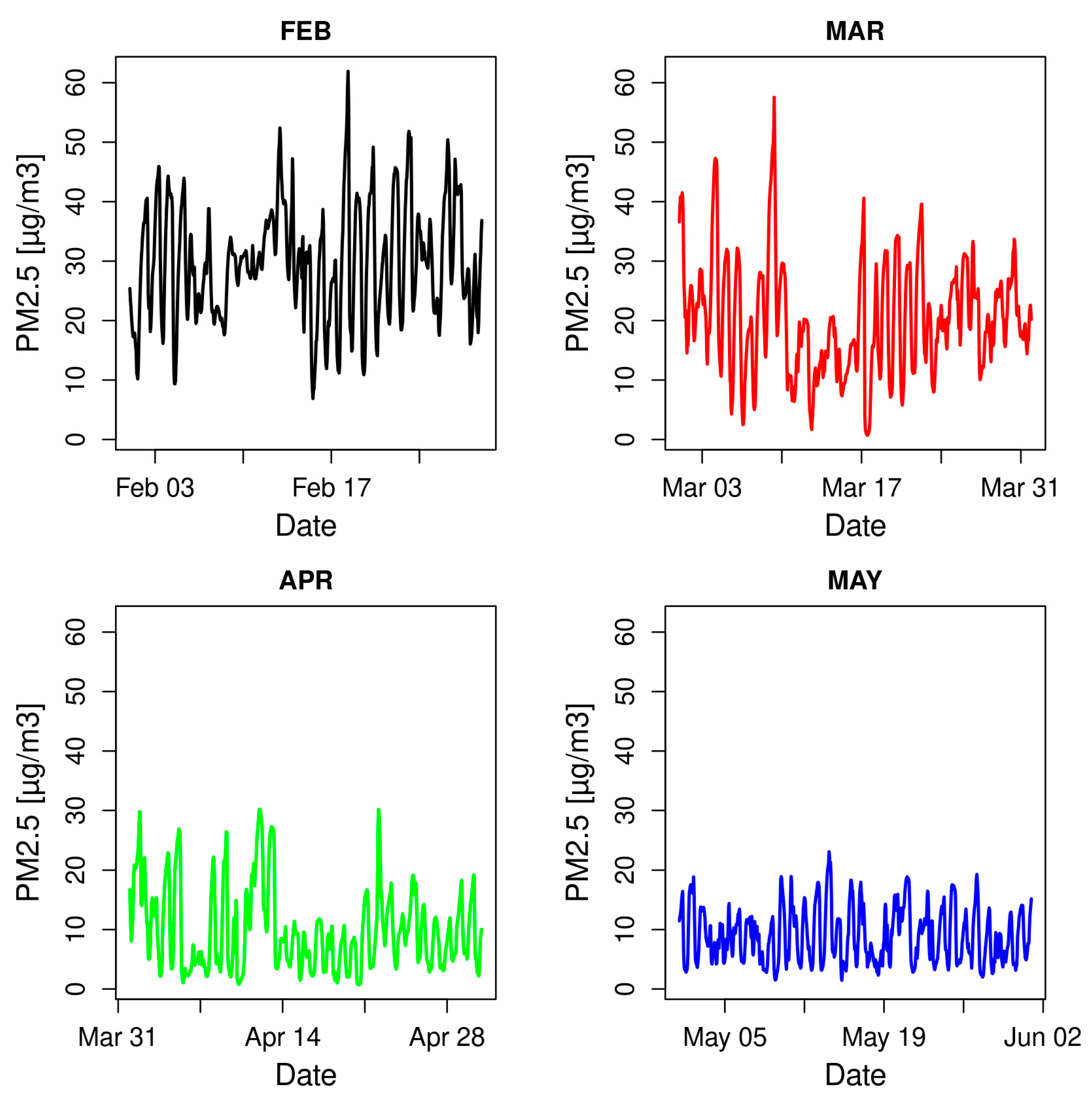
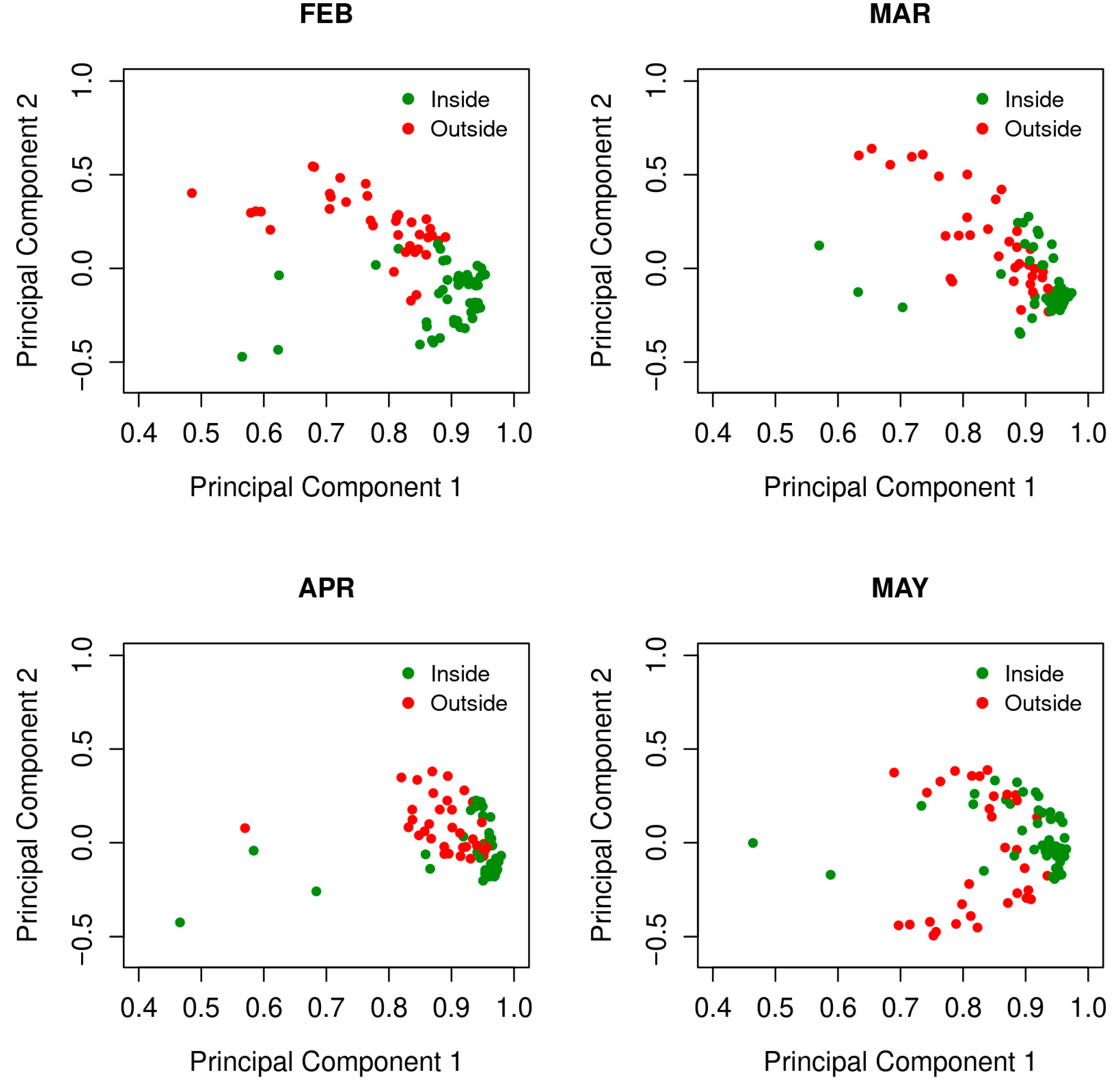

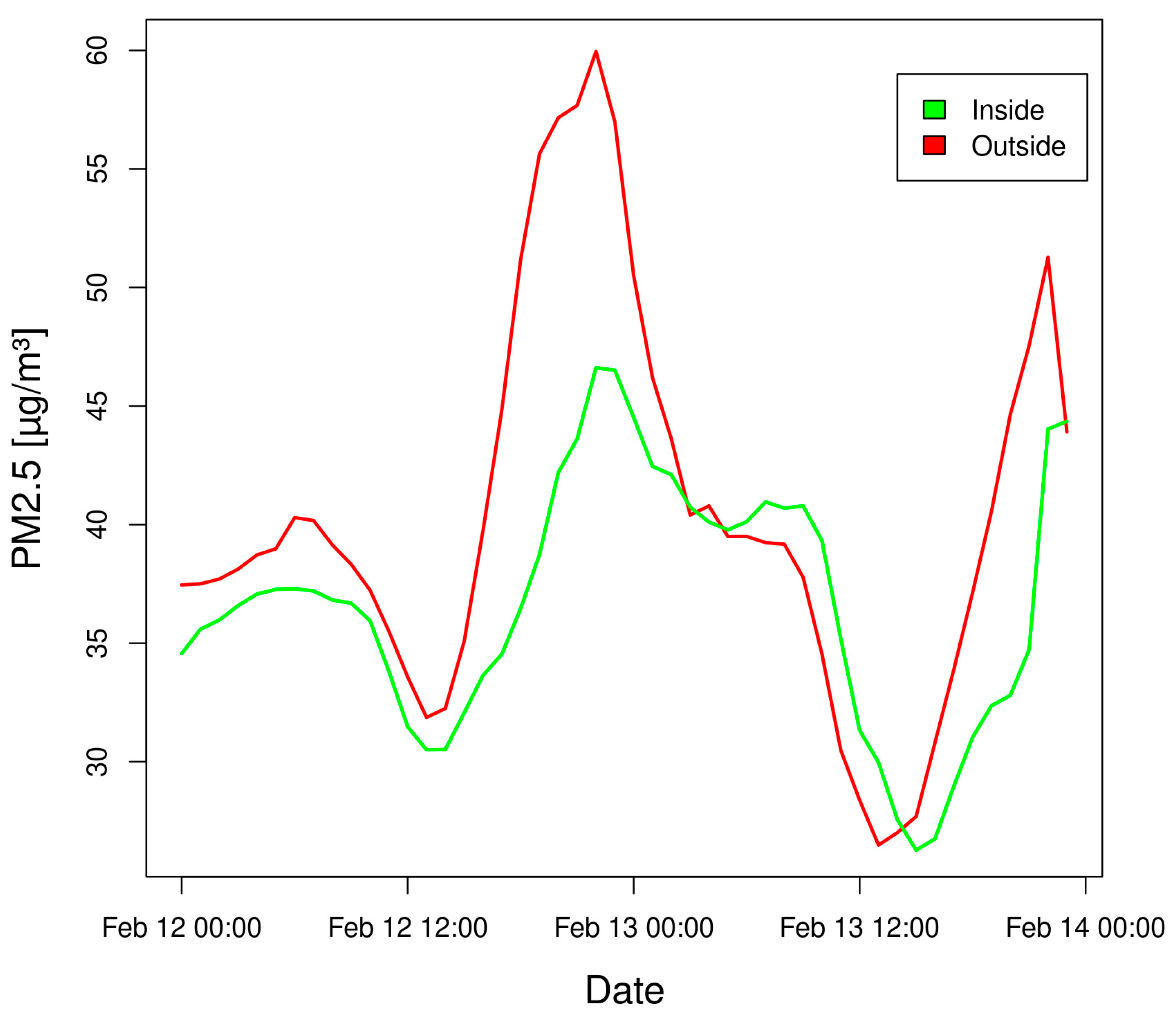

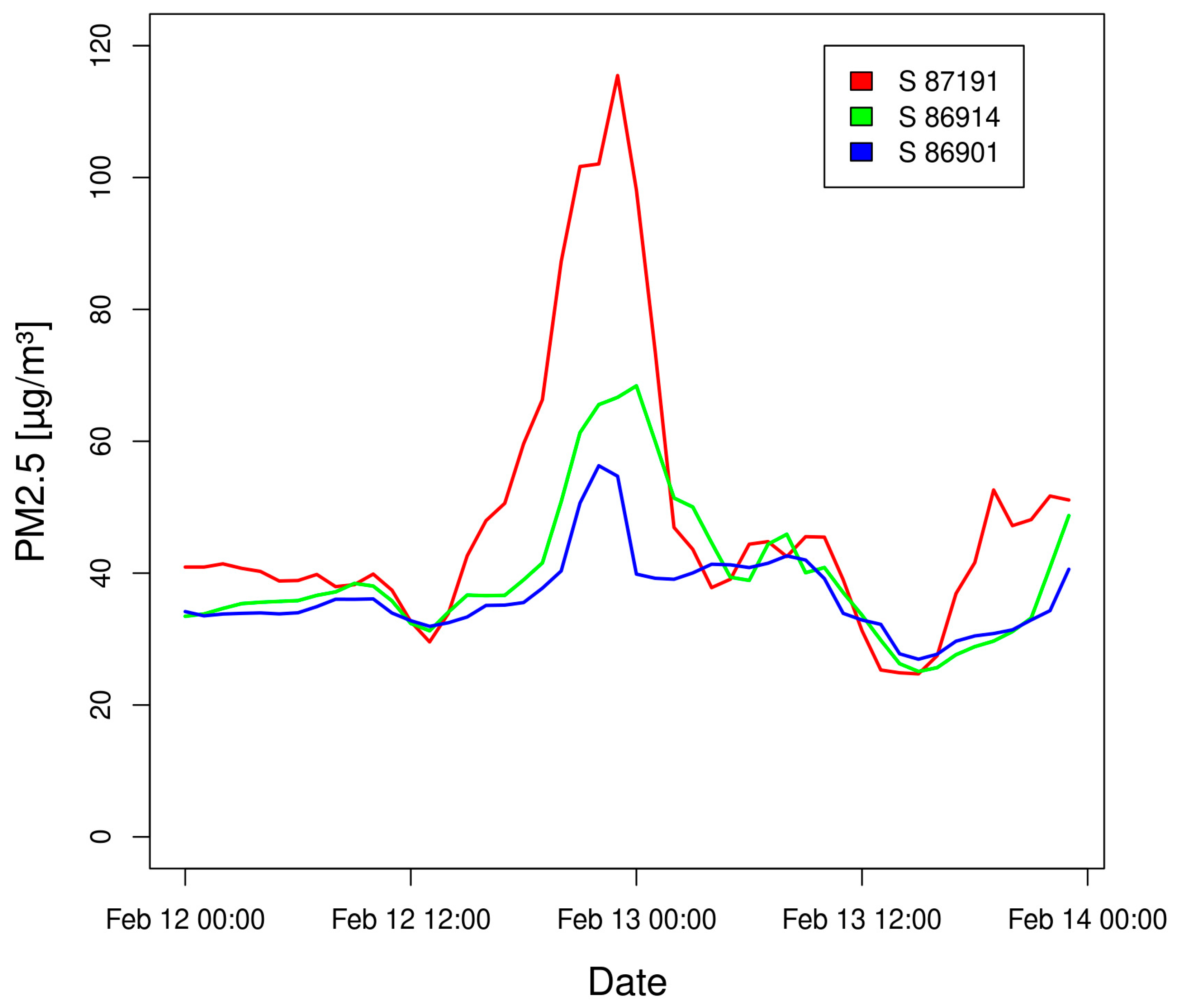
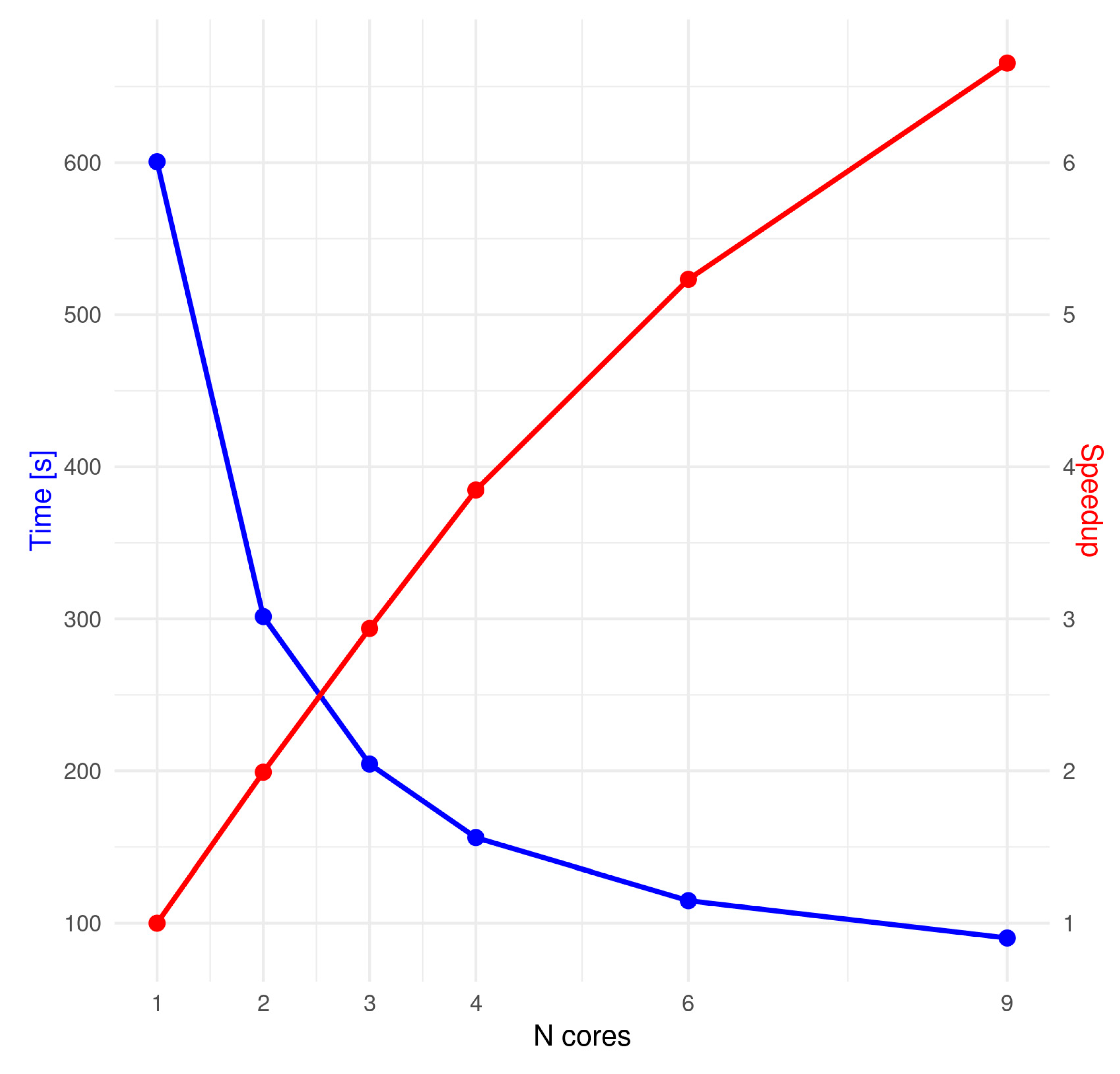
Disclaimer/Publisher’s Note: The statements, opinions and data contained in all publications are solely those of the individual author(s) and contributor(s) and not of MDPI and/or the editor(s). MDPI and/or the editor(s) disclaim responsibility for any injury to people or property resulting from any ideas, methods, instructions or products referred to in the content. |
© 2025 by the authors. Licensee MDPI, Basel, Switzerland. This article is an open access article distributed under the terms and conditions of the Creative Commons Attribution (CC BY) license (https://creativecommons.org/licenses/by/4.0/).
Share and Cite
Lipiec, D.; Lipiec, P.; Danek, T. Urban–Rural PM2.5 Dynamics in Kraków, Poland: Patterns and Source Attribution. Atmosphere 2025, 16, 1201. https://doi.org/10.3390/atmos16101201
Lipiec D, Lipiec P, Danek T. Urban–Rural PM2.5 Dynamics in Kraków, Poland: Patterns and Source Attribution. Atmosphere. 2025; 16(10):1201. https://doi.org/10.3390/atmos16101201
Chicago/Turabian StyleLipiec, Dorota, Piotr Lipiec, and Tomasz Danek. 2025. "Urban–Rural PM2.5 Dynamics in Kraków, Poland: Patterns and Source Attribution" Atmosphere 16, no. 10: 1201. https://doi.org/10.3390/atmos16101201
APA StyleLipiec, D., Lipiec, P., & Danek, T. (2025). Urban–Rural PM2.5 Dynamics in Kraków, Poland: Patterns and Source Attribution. Atmosphere, 16(10), 1201. https://doi.org/10.3390/atmos16101201







